Features
JUDO FIGHTING IN SRI LANKA – Part 56

CONFESSIONS OF A GLOBAL GYPSY
By Dr. Chandana (Chandi) Jayawardena DPhil
President – Chandi J. Associates Inc. Consulting, Canada
Founder & Administrator – Global Hospitality Forum
chandij@sympatico.ca
Discovering Judo in 1969
Just before I sat for the General Certificate of Education – Ordinary Level (grade 10) examinations in Ceylon in late 1969, I discovered Judo. Growing up in the Bambalapiitya Flats in Colombo, I noticed that the eldest son of the family in our next door flat, Raju Arulanandam. occasionally wore an unusual uniform with a brown linen belt while doing some fitness exercises. I had just turned 16 and Raju was about 10 years older than me. Due to his friendly personality and various athletic talents, Raju was our neighbourhood hero, who was very popular. Raju’s younger brother Roshan was around my age and a close friend of mine.
One day I saw Raju and Roshan (in similar uniforms) going to the beach behind our flat. When I followed them, I was baffled to see Raju throwing poor Roshan around on the beach. “What are you doing, Raju?”, I inquired. “Chandana, I am practicing Judo with Roshan as my sparring partner. I have a couple of fights in an important Judo tournament this weekend”, Raju’s response sparked an interest in me. I was very impressed when Raju did some rolling break falls when he was tackled at a neighbourhood rugby football game that evening. “Raju, I would love to learn Judo. Please introduce me to your Judo club” I requested.
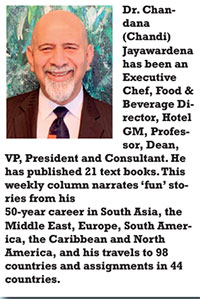
Around that period, my father was in Japan on a scholarship, undergoing some training in publishing books. When he heard of my new interest, he sent me a postcard from Osaka confirming that he would bring me a special present from Japan. It was a ‘Judogi’ or the traditional uniform used for Judo practice and competition. A Judogi comprises of three parts that are usually cut from different fabrics: a very heavy jacket, lighter canvas pants and a cotton belt. My parents included a condition before they let me follow Raju’s footsteps into Judo fighting. I had to complete the grade 10 examinations and pass with at least four credits, which I did. I commenced Judo at the Central YMCA in Colombo on January 2, 1970.
The Origin and the Ranks of Judo
Judo is a martial art that was born in Japan in 1882. It is known around the world as an Olympic sport, since the 1964 Tokyo Olympiad. Judo was created by Jigoro Kano combining jujutsu, a form of close combat with the elements of mental discipline. Judo (
柔道) means “gentle way” in Japanese. Jigoro Kano commenced Judo classes in a Buddhist temple in Tokyo.
Judo practitioners are called a ‘judokas, who are ranked according to their skill and knowledge. Their ranks are indicated by the colours of belts that they wear. There are two broad categories of ranks: those who have attained a level of competency at which they are considered worthy of a black belt or ‘Dan’ degree grades and those who have yet to attain that level, therefore hold ‘Kyu’ grades.
In the current system as used in Japan, there are six student grades ranked in descending numerical order. Beginners are given the rank of sixth kyu white belt, and once they get promoted to the third kyu, they are awarded brown belts. The first kyu is the last kyu rank before promotion to the first-degree black belt (Shodan). There are 10 dan ranks, which are in ascending numerical order (one to ten). Only 15 individuals have been promoted to the rank of 10th dan. The highest-ranking Judoka practicing in Sri Lanka today is a former Judo colleague of mine, A. H. Jinadasa (Jinna), who has the rank of 5th dan.
The objective of competitive judo is to throw an opponent, immobilize them with a pin, or force an opponent to submit with a joint lock or a choke hold. Judo’s international governing body is the International Judo Federation. The Kodokan Judo Institute in Japan is the headquarters of the worldwide Judo community.
Judo in Sri Lanka in the early 1970s
Soon after I started practising Judo in 1970, I had some quick successes. In my third month in Judo, I competed in the national sports festival of Ceylon, and was the runner up of the fifth and sixth kyu heavy wight event. The Japanese ambassador gave away Judo awards at that festival. He also arranged to send a few Judo instructors (sensei) from Japan to teach Judo in Ceylon.
At the Central YMCA in Colombo in 1970, I was inspired by a 20-year-old Judoka – Asoka Jayawardana. Having commenced Judo when he was 14, Asoka had become the youngest national Judo champion in 1969, at the age of 19. Asoka also had a cameo role in the most popular Sinhala movie of 1971, ‘Hathara Denama Sooyayo’ as a Judo fighter at Colombo YMCA, training one of the four heroes of the movie. That movie which ran for over 100 days island-wide during the first release, helped Judo to become more popular in Ceylon.
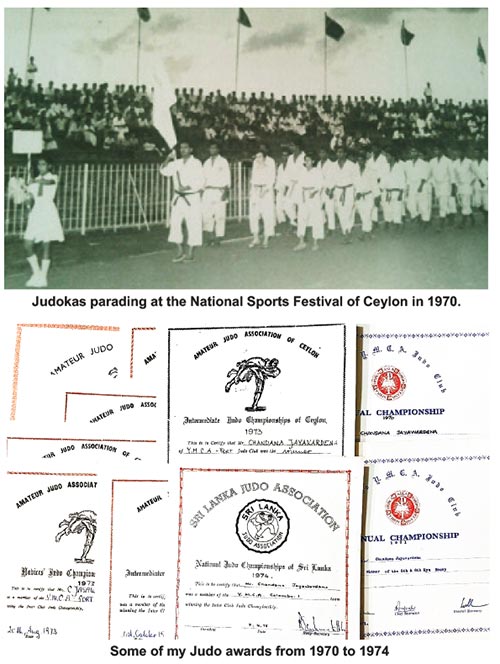
Asoka was also the Judo team leader of the Colombo YMCA. In 1972, he was awarded a two-year YMCA scholarship to study in Japan. Asoka studied at the Kodokan Judo Institute. Having done a six-month course at the Ceylon Hotel School, he had some interest in a career in the hotel industry. Therefore, during his two-years in Japan, Asoka concurrently studied hotel management. When he returned to Sri Lanka, while continuing Judo, he joined the hotel industry as a manager. In later years, a few more Sri Lankans went to Japan on Kodokan Judo scholarships.
I continued Judo for five years until the end of 1974. I also did wrestling and Karate for short periods. As Judo has a component of ground fighting on the mat, knowledge of wrestling is useful. Some clubs such as Colombo YMBA occasionally recruited top wrestlers of the country to Judo teams, and provided them with basic Judo training prior to major Judo tournaments. That strategy worked well at times.
I won the open category of the Intermediate Judo Championship of Sri Lanka in 1973. Among ten different categories of bouts based on grades and weights of the fighters, the open event was the prime event of any Judo tournament, at that time. My opponent in the open final was stronger, heavier and more experienced in fighting than I. He, S. I. Ratnayake was a tough Inspector of Police. I was still in my late teens and he was ten years older. My opponent was expected to win the final bout of the tournament easily.
However, I had lot of support around the fighting arena from my neighbourhood buddies and Ceylon Hotel School batchmates. My aim was not to disappoint my fans by losing quickly. I held my opponent at bay for the whole duration. Twice, extra fighting time was allocated by the referee. In between, during a short break from fighting, I was kneeling down and adjusting my belt at a corner of the fighting mat. While catching my breath, I told Roshan Arulanandan cheering me by the ringside that my opponent was strong like a big tree. He told me, “Strong trees can also fall down with the right pressure.” To me that summed up a key concept of the art of Judo fighting. Upsetting the balance of the opponent was a good tactic.
During the final three minutes of extra time, my strategy was to be very aggressive. I kept on pushing my opponent while holding his judogi as tightly as possible and pulling his neck down. That angered the police officer and he aggressively pushed me back. At that moment, I used his own strength and weight while pulling him towards me and falling backwards with my right foot pushing his stomach up. This sacrifice throw called ‘Tomoe Nage’ is one of the traditional forty throws of Judo developed by Jigoro Kano. It was not a popular throw, as often it backfired when tried against more senior and heavier opponents. That day it was my last resort. It worked for me like a charm and my opponent went flying over me and fell flat on his back. I won the fight and became a Judo champion.

The next year, I was chosen to be on the five-member team of the Colombo YMCA Judo club. After a hectic, five-bout team event, we won the 1974 national Judo Championship in Sri Lanka. After that, I stopped Judo for six years to focus on building a strong foundation for my career as a resort hotelier on the south coast of Sri Lanka.
Returning to Judo in the early 1980s
Six years later, on re-locating in Colombo in 1981, I re-started Judo at my club, the Central YMCA. I was happy to get an opportunity to practice Judo and hoped to study for Judo grade promotion tests, once again. Unfortunately, my busy work schedule did not allow me to do so. I was still a fourth Kyu level Judoka as I had faced only a couple of grading tests in the early 1970s. However, by 1982, I had improved my fighting and recorded some successes at the tournaments.
One full point in judo is termed in Japanese as ‘Ippon’. The competitor who gets awarded with an Ippon is declared the winner of the match, commonly by throwing the opponent to his back with force, speed and control. This would be considered a ‘perfect throw’ in judo. To the contrary, a half point is termed as ‘Waza-ari’. When two Waza-aris are awarded in a match, then it is equivalent to an Ippon and the match comes to an end.
JUDO There are three other ways to score an Ippon win, which are:
Immobilizing the opponent with a hold-down (grappling) technique for 20 seconds.
Choking the opponent until he ‘taps’ (gives up) or ‘naps’ (passes out). Pressure is applied to the sides of the neck, windpipe or larynx. A properly applied choking technique can cause the opponent to pass out.
Applying an armlock to an opponent’s elbow joint until he gives up or the arm becomes dislocated.
In 1982, I had a scary experience on the Judo mat. At a national tournament, I was fighting an opponent from the Colombo YMBA. This Judoka, Jayantha Seram, was a better and more experienced fighter compared to me. He threw me, but could not win a full point (Ippon) to beat me outright, as I fell sideways on one shoulder. Seram was awarded a Waza-ari. Without wasting anytime, he continued to fight aggressively by trying to hold-me down for 20 seconds, with an aim to score an Ippon win.
Seram was on top of me, but I was able to get a good grip on his Judogi to choke him. I applied pressure to the sides of his neck, as well as windpipe. I felt that it was working as his grip on me was gradually loosening. I took the opportunity to get off the mat and turn Seram down on the mat, while making the choke harder. As he did not tap me to indicate that he is giving up, I continued to choke him, aggressively.
The referee eventually stopped the fight to award me the win by Ippon, as froth came out of Seram’s mouth and he passed out. When I had turned him to the mat Seram had fallen with his hands behind his body, and neither of his hands were therefore free to tap. As the ambulance was taking a long time to arrive, I rushed Seram to the emergency room in my car to save his life. That day, I nearly gave up Judo.
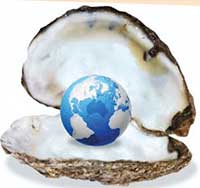
The First Overseas Trip of the National Judo Team
I was surprised when one of the highest-ranking Judokas in Sri Lanka, Kithsiri De Soyza, made an offer to me in 1982. “For the first time in the history of Judo in Sri Lanka, a national team of ten Judokas has been invited to compete in an international Judo tournament. It will be held in Ghaziabad, near New Delhi, next month, with teams from India, Pakistan, Bangladesh, Sri Lanka and Japan. I will be the captain of the national team and SP Upali Sahabandu will be the national team manager. We may also take part in smaller tournaments in two other Indian cities.” Kithsiri told me.
He then added, “Chandana, the Sri Lanka Judo Association has decided to include you as a member of the national team to participate in India.” Rank-wise, I was the most junior Judoka who was chosen to represent Sri Lanka, for the first international Judo tournament, Sri Lanka was invited to take part. I was simply fortunate to become a member of the Sri Lanka national Judo team, within a year of returning to the sport.
Ten members of the national team were selected from four Judo clubs – Four from the Colombo YMCA, four from the Colombo YMBA, one from the Ceylon Police Force and one from the Gampola Judo Club. In the middle of the hot summer of 1982, our team took off to five cities in India for two weeks, with hope, anxiety and ambition. To be continued next Sunday…
Features
The US-China rivalry and challenges facing the South
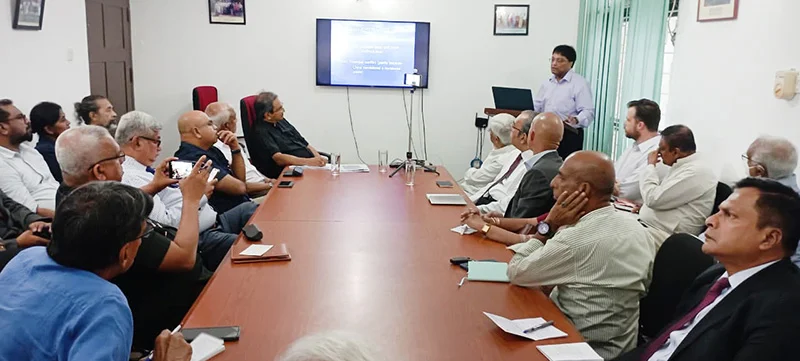
 The US-China rivalry could be said to make-up the ‘stuff and substance’ of world politics today but rarely does the international politics watcher and student of the global South in particular get the opportunity of having a balanced and comprehensive evaluation of this crucial relationship. But such a balanced assessment is vitally instrumental in making sense of current world power relations.
The US-China rivalry could be said to make-up the ‘stuff and substance’ of world politics today but rarely does the international politics watcher and student of the global South in particular get the opportunity of having a balanced and comprehensive evaluation of this crucial relationship. But such a balanced assessment is vitally instrumental in making sense of current world power relations.
Thanks to the Regional Centre for Strategic Studies (RCSS), Colombo the above window of opportunity was opened on December 8th for those sections of the public zealously pursuing an understanding of current issues in global politics. The knowledge came via a forum that was conducted at the RCSS titled, ‘The US-China Rivalry and Implications for the Indo-Pacific’, where Professor Neil DeVotta of the Wake Forest University of North Carolina in the US, featured as the speaker.
A widely representative audience was present at the forum, including senior public servants, the diplomatic corps, academics, heads of civil society organizations, senior armed forces personnel and the media. The event was ably managed by the Executive Director of the RCSS, retired ambassador Ravinatha Aryasinha. Following the main presentation a lively Q&A session followed, where many a point of interest was aired and discussed.
While there is no doubt that China is fast catching up with the US with regard to particularly military, economic, scientific and technological capability, Prof. DeVotta helped to balance this standard projection of ‘China’s steady rise’ by pointing to some vital facts about China, the omission of which would amount to the observer having a somewhat uninformed perception of global political realities.
The following are some of the facts about contemporary China that were highlighted by Prof. DeVotta:
* Money is steadily moving out of China and the latter’ s economy is slowing down. In fact the country is in a ‘ Middle Income Trap’. That is, it has reached middle income status but has failed to move to upper income status since then.
* People in marked numbers are moving out of China. It is perhaps little known that some Chinese are seeking to enter the US with a view to living there. The fact is that China’s population too is on the decline.
* Although the private sector is operative in China, there has been an increase in Parastatals; that is, commercial organizations run by the state are also very much in the fore. In fact private enterprises have begun to have ruling Communist Party cells in them.
* China is at its ‘peak power’ but this fact may compel it to act ‘aggressively’ in the international sphere. For instance, it may be compelled to invade Taiwan.
* A Hard Authoritarianism could be said to characterize central power in China today, whereas the expectation in some quarters is that it would shift to a Soft Authoritarian system, as is the case in Singapore.
* China’s influence in the West is greater than it has ever been.
The speaker was equally revelatory about the US today. Just a few of these observations are:
* The US is in a ‘Unipolar Moment’. That is, it is the world’s prime power. Such positions are usually not longstanding but in the case of the US this position has been enjoyed by it for quite a while.
* China is seen by the US as a ‘Revisionist Power’ as opposed to being a ‘Status Quo Power.’ That is China is for changing the world system slowly.
* The US in its latest national security strategy is paying little attention to Soft Power as opposed to Hard Power.
* In terms of this strategy the US would not allow any single country to dominate the Asia-Pacific region.
* The overall tone of this strategy is that the US should step back and allow regional powers to play a greater role in international politics.
* The strategy also holds that the US must improve economic ties with India, but there is very little mention of China in the plan.
Given these observations on the current international situation, a matter of the foremost importance for the economically weakest countries of the South is to figure out how best they could survive materially within it. Today there is no cohesive and vibrant collective organization that could work towards the best interests of the developing world and Dr. DeVotta was more or less correct when he said that the Non-alignment Movement (NAM) has declined.
However, this columnist is of the view that rather being a spent force, NAM was allowed to die out by the South. NAM as an idea could never become extinct as long as economic and material inequalities between North and South exist. Needless to say, this situation is remaining unchanged since the eighties when NAM allowed itself to be a non-entity so to speak in world affairs.
The majority of Southern countries did not do themselves any good by uncritically embracing the ‘market economy’ as a panacea for their ills. As has been proved, this growth paradigm only aggravated the South’s development ills, except for a few states within its fold.
Considering that the US would be preferring regional powers to play a more prominent role in the international economy and given the US’ preference to be a close ally of India, the weakest of the South need to look into the possibility of tying up closely with India and giving the latter a substantive role in advocating the South’s best interests in the councils of the world.
To enable this to happen the South needs to ‘get organized’ once again. The main differences between the past and the present with regard to Southern affairs is that in the past the South had outstanding leaders, such as Jawaharlal Nehru of India, who could doughtily stand up for it. As far as this columnist could ascertain, it is the lack of exceptional leaders that in the main led to the decline of NAM and other South-centred organizations.
Accordingly, an urgent task for the South is to enable the coming into being of exceptional leaders who could work untiringly towards the realization of its just needs, such as economic equity. Meanwhile, Southern countries would do well to, indeed, follow the principles of NAM and relate cordially with all the major powers so as to realizing their best interests.
Features
Sri Lanka and Global Climate Emergency: Lessons of Cyclone Ditwah
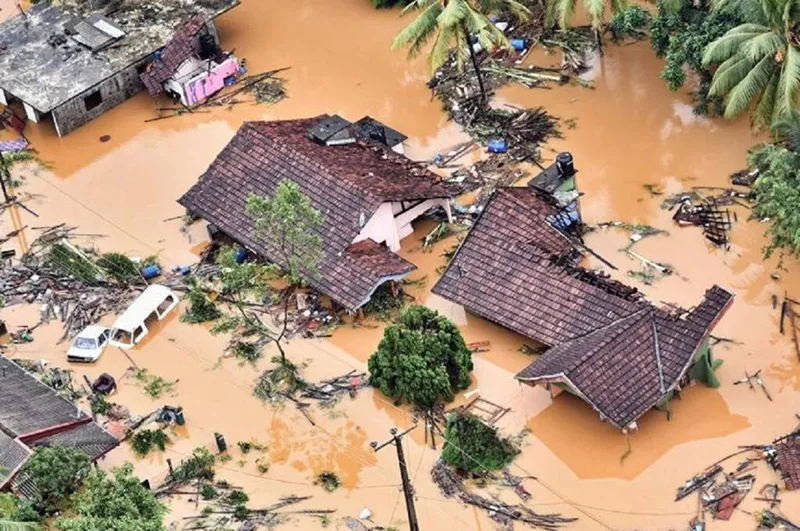
Tropical Cyclone Ditwah, which made landfall in Sri Lanka on 28 November 2025, is considered the country’s worst natural disaster since the deadly 2004 tsunami. It intensified the northeast monsoon, bringing torrential rainfall, massive flooding, and 215 severe landslides across seven districts. The cyclone left a trail of destruction, killing nearly 500 people, displacing over a million, destroying homes, roads, and railway lines, and disabling critical infrastructure including 4,000 transmission towers. Total economic losses are estimated at USD 6–7 billion—exceeding the country’s foreign reserves.
The Sri Lankan Armed Forces have led the relief efforts, aided by international partners including India and Pakistan. A Sri Lanka Air Force helicopter crashed in Wennappuwa, killing the pilot and injuring four others, while five Sri Lanka Navy personnel died in Chundikkulam in the north while widening waterways to mitigate flooding. The bravery and sacrifice of the Sri Lankan Armed Forces during this disaster—as in past disasters—continue to be held in high esteem by grateful Sri Lankans.
The Sri Lankan government, however, is facing intense criticism for its handling of Cyclone Ditwah, including failure to heed early warnings available since November 12, a slow and poorly coordinated response, and inadequate communication with the public. Systemic issues—underinvestment in disaster management, failure to activate protocols, bureaucratic neglect, and a lack of coordination among state institutions—are also blamed for avoidable deaths and destruction.
The causes of climate disasters such as Cyclone Ditwah go far beyond disaster preparedness. Faulty policymaking, mismanagement, and decades of unregulated economic development have eroded the island’s natural defenses. As climate scientist Dr. Thasun Amarasinghe notes:
“Sri Lankan wetlands—the nation’s most effective natural flood-control mechanism—have been bulldosed, filled, encroached upon, and sold. Many of these developments were approved despite warnings from environmental scientists, hydrologists, and even state institutions.”
Sri Lanka’s current vulnerabilities also stem from historical deforestation and plantation agriculture associated with colonial-era export development. Forest cover declined from 82% in 1881 to 70% in 1900, and to 54–50% by 1948, when British rule ended. It fell further to 44% in 1954 and to 16.5% by 2019.
Deforestation contributes an estimated 10–12% of global greenhouse gas emissions. Beyond removing a vital carbon sink, it damages water resources, increases runoff and erosion, and heightens flood and landslide risk. Soil-depleting monocrop agriculture further undermines traditional multi-crop systems that regenerate soil fertility, organic matter, and biodiversity.
In Sri Lanka’s Central Highlands, which were battered by Cyclone Ditwah, deforestation and unregulated construction had destabilised mountain slopes. Although high-risk zones prone to floods and landslides had long been identified, residents were not relocated, and construction and urbanisation continued unchecked.
Sri Lanka was the first country in Asia to adopt neoliberal economic policies. With the “Open Economy” reforms of 1977, a capitalist ideology equating human well-being with quantitative growth and material consumption became widespread. Development efforts were rushed, poorly supervised, and frequently approved without proper environmental assessment.
Privatisation and corporate deregulation weakened state oversight. The recent economic crisis and shrinking budgets further eroded environmental and social protections, including the maintenance of drainage networks, reservoirs, and early-warning systems. These forces have converged to make Sri Lanka a victim of a dual climate threat: gradual environmental collapse and sudden-onset disasters.
Sri Lanka: A Climate Victim
Sri Lanka’s carbon emissions remain relatively small but are rising. The impact of climate change on the island, however, is immense. Annual mean air temperature has increased significantly in recent decades (by 0.016 °C annually between 1961 and 1990). Sea-level rise has caused severe coastal erosion—0.30–0.35 meters per year—affecting nearly 55% of the shoreline. The 2004 tsunami demonstrated the extreme vulnerability of low-lying coastal plains to rising seas.
The Cyclone Ditwah catastrophe was neither wholly new nor surprising. In 2015, the Geneva-based Internal Displacement Monitoring Centre (IDMC) identified Sri Lanka as the South Asian country with the highest relative risk of disaster-related displacement: “For every million inhabitants, 15,000 are at risk of being displaced every year.”
IDMC also noted that in 2017 the country experienced seven disaster events—mainly floods and landslides—resulting in 135,000 new displacements and that Sri Lanka “is also at risk for slow-onset impacts such as soil degradation, saltwater intrusion, water scarcity, and crop failure”.
Sri Lanka ranked sixth among countries most affected by extreme weather events in 2018 (Germanwatch) and second in 2019 (Global Climate Risk Index). Given these warnings, Cyclone Ditwah should not have been a surprise. Scientists have repeatedly cautioned that warmer oceans fuel stronger cyclones and warmer air holds more moisture, leading to extreme rainfall. As the Ceylon Today editorial of December 1, 2025 also observed:
“…our monsoons are no longer predictable. Cyclones form faster, hit harder, and linger longer. Rainfall becomes erratic, intense, and destructive. This is not a coincidence; it is a pattern.”
Without urgent action, even more extreme weather events will threaten Sri Lanka’s habitability and physical survival.
A Global Crisis
Extreme weather events—droughts, wildfires, cyclones, and floods—are becoming the global norm. Up to 1.2 billion people could become “climate refugees” by 2050. Global warming is disrupting weather patterns, destabilising ecosystems, and posing severe risks to life on Earth. Indonesia and Thailand were struck by the rare and devastating Tropical Cyclone Senyar in late November 2025, occurring simultaneously with Cyclone Ditwah’s landfall in Sri Lanka.
More than 75% of global greenhouse gas emissions—and nearly 90% of carbon emissions—come from burning coal, oil, and gas, which supply about 80% of the world’s energy. Countries in the Global South, like Sri Lanka, which contribute least to greenhouse gas emissions, are among the most vulnerable to climate devastation. Yet wealthy nations and multilateral institutions, including the World Bank, continue to subsidise fossil fuel exploration and production. Global climate policymaking—including COP 30 in Belém, Brazil, in 2025—has been criticised as ineffectual and dominated by fossil fuel interests.
If the climate is not stabilised, long-term planetary forces beyond human control may be unleashed. Technology and markets are not inherently the problem; rather, the issue lies in the intentions guiding them. The techno-market worldview, which promotes the belief that well-being increases through limitless growth and consumption, has contributed to severe economic inequality and more frequent extreme weather events. The climate crisis, in turn, reflects a profound mismatch between the exponential expansion of a profit-driven global economy and the far slower evolution of human consciousness needed to uphold morality, compassion, generosity and wisdom.
Sri Lanka’s 2025–26 budget, adopted on November 14, 2025—just as Cyclone Ditwah loomed—promised subsidised land and electricity for companies establishing AI data centers in the country.
President Anura Kumara Dissanayake told Parliament: “Don’t come questioning us on why we are giving land this cheap; we have to make these sacrifices.”
Yet Sri Lanka is a highly water-stressed nation, and a growing body of international research shows that AI data centers consume massive amounts of water and electricity, contributing significantly to greenhouse gas emissions.
The failure of the narrow, competitive techno-market approach underscores the need for an ecological and collective framework capable of addressing the deeper roots of this existential crisis—both for Sri Lanka and the world.
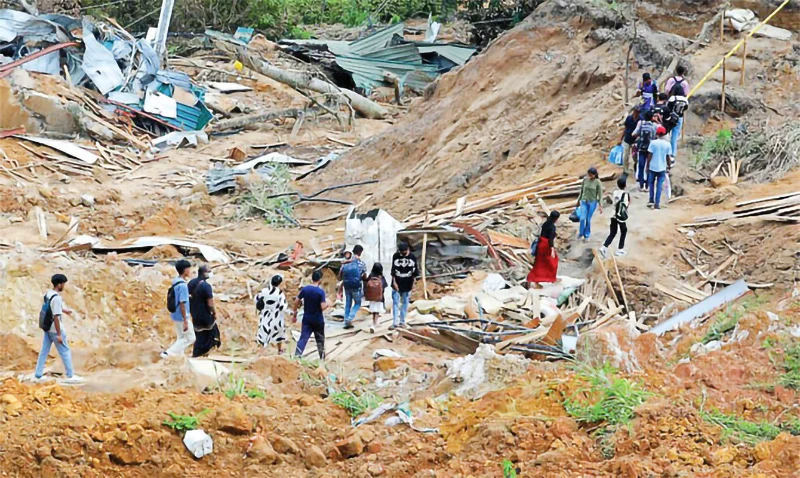
A landslide in Sri Lanka (AFP picture)
Ecological and Human Protection
Ecological consciousness demands
recognition that humanity is part of the Earth, not separate from it. Policies to address climate change must be grounded in this understanding, rather than in worldviews that prize infinite growth and technological dominance. Nature has primacy over human-created systems: the natural world does not depend on humanity, while humanity cannot survive without soil, water, air, sunlight, and the Earth’s essential life-support systems.
Although a climate victim today, Sri Lanka is also home to an ancient ecological civilization dating back to the arrival of the Buddhist monk Mahinda Thera in the 3rd century BCE. Upon meeting King Devanampiyatissa, who was out hunting in Mihintale, Mahinda Thera delivered one of the earliest recorded teachings on ecological interdependence and the duty of rulers to protect nature:
“O great King, the birds of the air and the beasts of the forest have as much right to live and move about in any part of this land as thou. The land belongs to the people and all living beings; thou art only its guardian.”
A stone inscription at Mihintale records that the king forbade the killing of animals and the destruction of trees. The Mihintale Wildlife Sanctuary is believed to be the world’s first.
Sri Lanka’s ancient dry-zone irrigation system—maintained over more than a millennium—stands as a marvel of sustainable development. Its network of interconnected reservoirs, canals, and sluices captured monsoon waters, irrigated fields, controlled floods, and even served as a defensive barrier. Floods occurred, but historical records show no disasters comparable in scale, severity, or frequency to those of today. Ancient rulers, including the legendary reservoir-builder King Parākramabāhu, and generations of rice farmers managed their environment with remarkable discipline and ecological wisdom.
The primacy of nature became especially evident when widespread power outages and the collapse of communication networks during Cyclone Ditwah forced people to rely on one another for survival. The disaster ignited spontaneous acts of compassion and solidarity across all communities—men and women, rich and poor, Buddhists, Christians, Muslims, and Hindus. Local and international efforts mobilized to rescue, shelter, feed, and emotionally support those affected. These actions demonstrated a profound human instinct for care and cooperation, often filling vacuums left by formal emergency systems.
Yet spontaneous solidarity alone is insufficient. Sri Lanka urgently needs policies on sustainable development, environmental protection, and climate resilience. These include strict, science-based regulation of construction; protection of forests and wetlands; proper maintenance of reservoirs; and climate-resilient infrastructure. Schools should teach environmental literacy that builds unity and solidarity, rather than controversial and divisive curriculum changes like the planned removal of history and introduction of contested modules on gender and sexuality.
If the IMF and international creditors—especially BlackRock, Sri Lanka’s largest sovereign bondholder, valued at USD 13 trillion—are genuinely concerned about the country’s suffering, could they not cancel at least some of Sri Lanka’s sovereign debt and support its rebuilding efforts? Addressing the climate emergency and the broader existential crisis facing Sri Lanka and the world ultimately requires an evolution in human consciousness guided by morality, compassion, generosity and wisdom. (Courtesy: IPS NEWS)
Dr Asoka Bandarage is the author of Colonialism in Sri Lanka: The Political Economy of the Kandyan Highlands, 1833-1886 (Mouton) Women, Population and Global Crisis: A Politico-Economic Analysis (Zed Books), The Separatist Conflict in Sri Lanka: Terrorism, Ethnicity, Political Economy, ( Routledge), Sustainability and Well-Being: The Middle Path to Environment, Society and the Economy (Palgrave MacMillan) Crisis in Sri Lanka and the World: Colonial and Neoliberal Origins, Ecological and Collective Alternatives (De Gruyter) and numerous other publications. She serves on the Advisory Boards of the Interfaith Moral Action on Climate and Critical Asian Studies.
Features
Cliff and Hank recreate golden era of ‘The Young Ones’

 Cliff Richard and Hank Marvin’s reunion concert at the Riverside Theatre in Perth, Australia, on 01 November, 2025, was a night to remember.
Cliff Richard and Hank Marvin’s reunion concert at the Riverside Theatre in Perth, Australia, on 01 November, 2025, was a night to remember.
The duo, who first performed together in the 1950s as part of The Shadows, brought the house down with their classic hits and effortless chemistry.
The concert, part of Cliff’s ‘Can’t Stop Me Now’ tour, featured iconic songs like ‘Summer Holiday’, ‘The Young Ones’, ‘Bachelor Boy’, ‘Living Doll’ and a powerful rendition of ‘Mistletoe and Wine.’
Cliff, 85, and Hank, with his signature red Fender Stratocaster, proved that their music and friendship are timeless.
According to reports, the moment the lights dimmed and the first chords of ‘Move It’ rang out, the crowd knew they were in for something extraordinary.
Backed by a full band, and surrounded by dazzling visuals, Cliff strode onto the stage in immaculate form – energetic and confident – and when Hank Marvin joined him mid-set, guitar in hand, the audience erupted in applause that shook the hall.
Together they launched into ‘The Young Ones’, their timeless 1961 hit which brought the crowd to its feet, with many in attendance moved to tears.
The audience was treated to a journey through time, with vintage film clips and state-of-the-art visuals adding to the nostalgic atmosphere.
Highlights of the evening included Cliff’s powerful vocals, Hank’s distinctive guitar riffs, and their playful banter on stage.
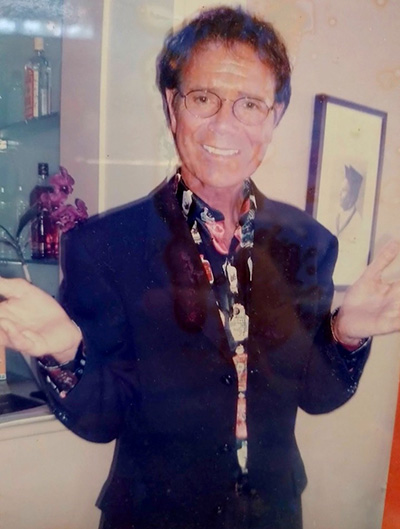
Cliff posing for The Island photographer … February,
2007
Cliff paused between songs to reflect on their shared journey saying:
“It’s been a lifetime of songs, memories, and friendship. Hank and I started this adventure when we were just boys — and look at us now, still up here making noise!”
As the final chords of ‘Congratulations’ filled the theatre, the crowd rose for a thunderous standing ovation that lasted several minutes.
Cliff waved, Hank gave a humble bow, and, together, they left the stage, arm-in-arm, to the refrain of “We’re the young ones — and we always will be.”
Reviews of the show were glowing, with fans and critics alike praising the duo’s energy, camaraderie, and enduring talent.
Overall, the Cliff Richard and Hank Marvin reunion concert was a truly special experience, celebrating the music and friendship that has captivated audiences for decades.
When Cliff Richard visited Sri Lanka, in February, 2007, I was invited to meet him, in his suite, at a hotel, in Colombo, and I presented him with my music page, which carried his story, and he was impressed.
In return, he personally autographed a souvenir for me … that was Cliff Richard, a truly wonderful human being.
-

 News3 days ago
News3 days agoOver 35,000 drug offenders nabbed in 36 days
-

 Business5 days ago
Business5 days agoLOLC Finance Factoring powers business growth
-

 News2 days ago
News2 days agoCyclone Ditwah leaves Sri Lanka’s biodiversity in ruins: Top scientist warns of unseen ecological disaster
-

 Features1 day ago
Features1 day agoFinally, Mahinda Yapa sets the record straight
-

 News5 days ago
News5 days agoCPC delegation meets JVP for talks on disaster response
-

 News5 days ago
News5 days agoA 6th Year Accolade: The Eternal Opulence of My Fair Lady
-

 News3 days ago
News3 days agoRising water level in Malwathu Oya triggers alert in Thanthirimale
-
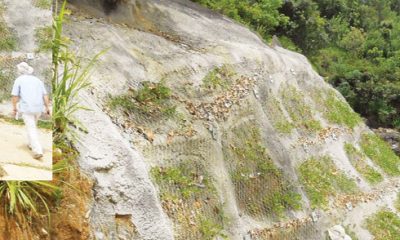
 Features4 days ago
Features4 days agoThe Catastrophic Impact of Tropical Cyclone Ditwah on Sri Lanka:













